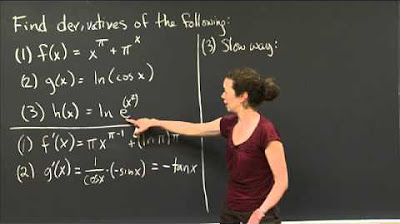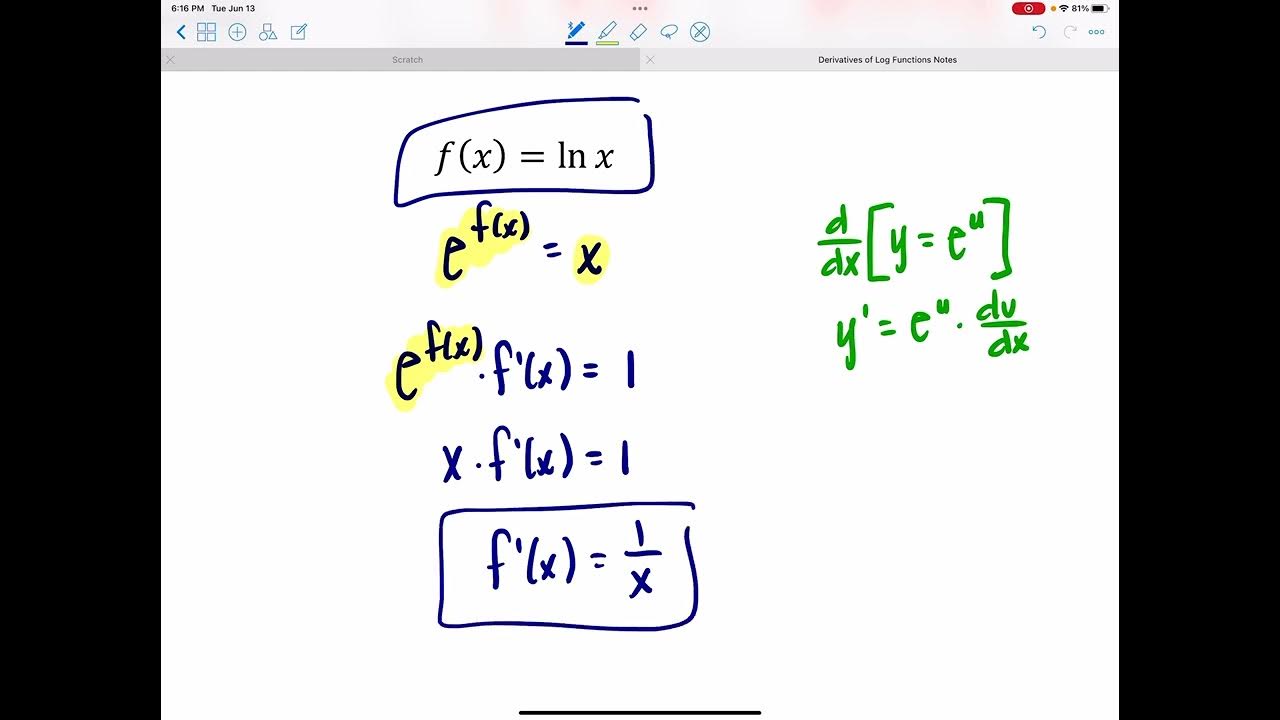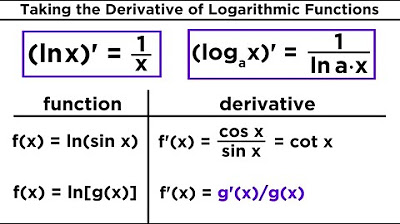Derivatives of Exponential Functions
TLDRIn this educational video, the instructor delves into the derivatives of exponential functions, focusing on e^x and variations like 2^x and 5^x. The lesson begins with solving exponential and logarithmic equations, utilizing properties like taking the natural log of both sides. The instructor then explains the derivative of e^u, which is e^u times the derivative of u, and demonstrates this with examples. The chain rule is applied when differentiating composite functions, such as sine of e^x squared. The video also reviews the derivatives of natural logarithms and the concept of reciprocal slopes for inverse functions. The instructor concludes with a discussion on points of inflection and relative extrema, providing a comprehensive guide to understanding the calculus of exponential functions.
Takeaways
- 📚 The video covers the derivation of exponential functions, especially those involving 'e' to the power of 'x', and also touches on '2' to the power of 'x' and '5' to the power of 'x'.
- 🔍 The script begins with solving exponential and logarithmic equations, emphasizing the use of natural logarithms to simplify equations with exponents.
- 📈 The presenter demonstrates how to isolate variables in exponential equations by using properties of logarithms and exponents.
- 🧮 An example is provided where the natural log of 'e' to the power of 'x' plus 1 is set equal to the natural log of 7, and the solution is found to be approximately 0.946.
- 📝 The base of the natural logarithm ('ln') is 'e', and the script shows how to rewrite equations using this property to solve for variables.
- 🔑 The derivative of 'e' to the power of 'u' is 'e' to the power of 'u' times the derivative of 'u' with respect to 'x'.
- 📉 The chain rule is applied when differentiating composite functions, such as the sine of 'e' to the power of 'x' squared.
- 🔄 The script highlights the neat property that the derivative of 'e' to the power of 'x' is simply 'e' to the power of 'x', indicating a slope equal to the function's value.
- 🤔 The inverse relationship between 'e' to the power of 'x' and the natural logarithm is discussed, noting that their derivatives have reciprocal slopes.
- 📚 The derivative of the natural logarithm function is the reciprocal of the variable, '1/x', which is a fundamental concept in calculus.
- 📉 The video script also reviews the product rule and chain rule in the context of derivatives, providing examples of their application.
- 📊 Finally, the script discusses finding points of inflection and relative extrema by analyzing the first and second derivatives of a function, with an example provided.
Q & A
What is the main topic discussed in the video script?
-The main topic discussed in the video script is the derivatives of exponential functions, particularly focusing on functions involving e to the power of x, as well as solving exponential and logarithmic equations.
How does the script suggest solving an exponential equation with an exponent containing a variable?
-The script suggests taking the natural log of both sides of the equation to bring the exponent down, simplifying the equation and solving for the variable.
What property is used when dealing with the natural log of e raised to a variable?
-The property used is that the natural log of e to the power of a variable is simply the variable itself, which simplifies the equation to just the variable.
How is the derivative of e to the power of u calculated in the script?
-The derivative of e to the power of u is calculated as e to the power of u times the derivative of u with respect to x, which is e^u * u'.
What is the chain rule, and how is it applied in the script to find the derivative of sine of e to the power of x squared?
-The chain rule is a method for finding the derivative of a composite function. In the script, it is applied by taking the derivative of the outer function (sine) and the derivative of the inner function (e to the power of x squared), then multiplying these derivatives together.
Why is the derivative of e to the power of x considered neat in the script?
-The derivative of e to the power of x is considered neat because it simplifies to e to the power of x, which is the same as the original function, indicating a constant rate of change.
What is the relationship between the derivatives of e to the x and the natural log of x?
-The derivatives of e to the x and the natural log of x are reciprocals of each other. The derivative of e to the x is e to the x, while the derivative of the natural log of x is 1/x.
How does the script handle the derivative of a natural log function with an exponent?
-The script suggests rewriting the natural log function with an exponent as the exponent in front of the natural log before taking the derivative, then applying the chain rule to find the derivative.
What is the product rule, and how is it used in the script to find the derivative of e to the x times y?
-The product rule states that the derivative of a product of two functions is the derivative of the first function times the second function plus the first function times the derivative of the second function. In the script, it is used to find the derivative of e to the x times y by multiplying e to the x with the derivative of y and y with the derivative of e to the x.
How does the script determine points of inflection and relative extrema for a given function?
-The script determines points of inflection and relative extrema by first finding the first derivative (F prime) and setting it to zero to find critical points. Then, it finds the second derivative (F double prime) and checks for sign changes to determine concavity and inflection points. Relative extrema are identified by the change in sign of F prime.
Outlines
📚 Introduction to Exponential Functions and Derivatives
This paragraph introduces the topic of derivatives of exponential functions, specifically focusing on functions involving e^x. The speaker discusses solving exponential and logarithmic equations, emphasizing the use of natural logarithms to simplify expressions. They demonstrate how to isolate variables in exponents by taking the natural log of both sides, leading to a solution for x. The paragraph also touches on the properties of logarithms and exponential functions, such as the base of the natural log being e, and how to rewrite equations to facilitate solving. The speaker concludes by introducing the concept of derivatives, explaining that the derivative of e^u is e^u times the derivative of u, and illustrating this with examples.
🔍 Derivative Rules and Chain Rule Application
In this paragraph, the speaker delves deeper into the derivatives of exponential functions, explaining the application of the chain rule. They illustrate how to differentiate composite functions, such as sine of e^x squared, by applying the chain rule. The derivative of e^x is highlighted as a constant function, with its derivative being e^x. The speaker also discusses the derivative of the natural log function, which is the reciprocal of the variable x. They emphasize the reciprocal relationship between the slopes of inverse functions, such as e^x and ln(x). The paragraph further explores the derivative of natural log functions involving exponents, demonstrating how to rewrite the expression before differentiation to simplify the process. The speaker also briefly reviews the product rule for derivatives, providing an example involving e^(-x) and its derivative.
📉 Analyzing Critical Points and Inflection Points
The final paragraph focuses on analyzing the critical points and inflection points of a function. The speaker explains the process of finding relative extrema and points of inflection by examining the first and second derivatives. They demonstrate how to use the product rule to find the first and second derivatives of a function involving e^x. The speaker identifies a critical point at x = -1 and an inflection point at x = -2, explaining how the sign changes in the first and second derivatives indicate whether the function is increasing or decreasing, and whether it is concave up or down. The paragraph concludes with a brief discussion on how to graph these points and understand their significance in the context of the function's behavior.
Mindmap
Keywords
💡Derivatives
💡Exponential Functions
💡Natural Logarithm
💡Logarithmic Equations
💡Chain Rule
💡Inverse Functions
💡Product Rule
💡Relative Extrema
💡Points of Inflection
💡Critical Points
Highlights
Introduction to derivatives of exponential functions, specifically focusing on e^x.
Practice of precalculus skills, including solving exponential and logarithmic equations.
Use of natural logarithm to simplify equations involving exponents.
Derivative of e^x is e^x, demonstrating a key property of exponential functions.
Application of the chain rule in finding derivatives of functions like sin(e^x)^2.
Derivative of natural log functions, showing the reciprocal relationship with exponential functions.
Explanation of how inverse functions have reciprocal slopes, a fundamental concept in calculus.
Derivative of natural log functions involving exponents, using properties of logarithms.
Use of product rule in derivatives, illustrated with an example involving e^(-x).
Simplification of derivatives by rewriting expressions before applying the derivative.
Finding critical points and points of inflection using derivatives, a key application in calculus.
Identification of a relative minimum by analyzing the sign changes of the first derivative.
Determination of a point of inflection by analyzing the sign changes of the second derivative.
Graphical representation of the function and its derivatives, aiding in visual understanding.
Review of derivative properties of constant functions, emphasizing their simplicity.
Detailed walkthrough of solving logarithmic equations, providing a step-by-step approach.
Comprehensive review of derivatives, including product rule and chain rule applications.
Transcripts
Browse More Related Video

Derivatives of Exponential Functions

Log and Exponent Derivatives | MIT 18.01SC Single Variable Calculus, Fall 2010

Derivatives of Log Functions

Derivatives of Logarithmic and Exponential Functions

Exponential functions differentiation intro | Advanced derivatives | AP Calculus AB | Khan Academy

Calculus 2 Lecture 6.3: Derivatives and Integrals of Exponential Functions
5.0 / 5 (0 votes)
Thanks for rating: